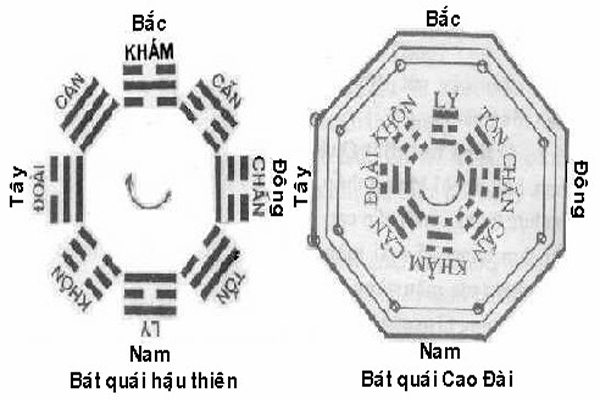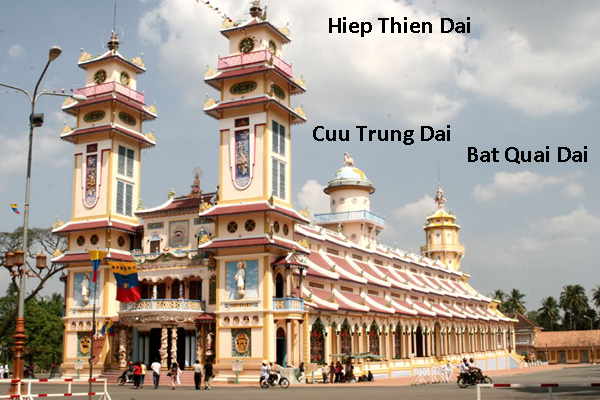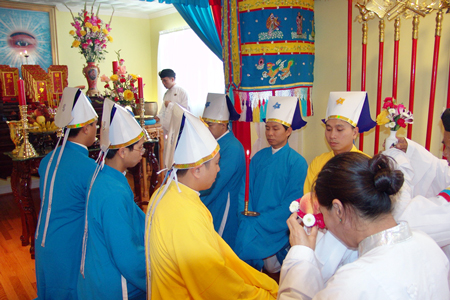Caodaism is divided into many sects, each of which has its own organization based on Phap Chanh truyen and Tan luat. Most of the founders and leaders of Caodaism were French officials, landlords, and those from the middle and...
Caodaism is divided into many sects, each of which has its own organization based on Phap Chanh truyen and Tan luat. Most of the founders and leaders of Caodaism were French officials, landlords, and those from the middle and lower middle classes. Therefore, they had a thorough knowledge of political institutions in the world. They believed that the constitutional monarchy (as in Japan) was the best form of government, and that it was the best choice for Vietnam. For them, it would be both loyal to the tradition and suitable with the democratic spirit of the new age in Vietnam. As a result, the structure of Caodaism was based on both the governmental model of Japan and the organizational model of the Vatican with more redundant and bureaucratic complements.
There are a great number of dignitaries of different ranks in Caodaism. These ranks reflect the system of religious titles in Catholicism, but they are described in sophisticated Sino- Vietnamese words for their increased mysteriousness.
The organizational system of Caodaism includes three central bodies, including Bat Quai Dai, Hiep Thien Dai and Cuu Trung Dai. The first is invisible while the rest are visible.
Bat Quai Dai (Pa Kua Palace) is the place of worship, which is dedicated to Buddha, saints, holy spirits and fairies. It is under the management of Li Bai, on behalf of God.

Hiep Thien Dai (Heavenly Union Palace) is the legislative and judicial body of Caodaism. Normally, it holds a seance with God for his instructions before promulgating rules related to the religion or the society. It is headed by Ho phap, the highest Caodaist dignitary. Under Ho phap are Thuong pham and Thuong sanh. Under these two dignitaries are twelve Thoi quan belonging to three branches: Phap (dharma), Dao (religion) and The (education).
The Phap branch is under the direction of Ho phap and in charge of law-related matters. It includes four Thoi quan, namely Tiep phap, Khai phap, Bao phap and Hien phap.
The Dao branch is under the direction of Thuong pham and in charge of the practice of the religion. It includes four Thoi quan, namely Tiep dao, Khai dao, Bao dao and Hien dao.
The The branch is under the direction of Thuong sanh and in charge of the training, education and inheritance of the religion. It includes four Thoi quan, namely Tiep the, Khai the, Bao the and Hien the.
These three branches are assisted by organs such as sanghas and academies.
Cuu Trung Dai (Nine Planes of Hierarchy) is the executive body of Caodaism. It is comprised of nine institutes, namely Ho, Luong, Cong, Hoc, Y, Nong, Hoa, Lai and Le, equivalent to the nine ministries of a government. Its dignitaries belong to three sections: Thai (Buddhist section), Thuong (Taoist section) and Ngoc (Confucian section), managing three institutes each.
Cuu Trung Dai is headed by Giao tong, equivalent to the prime minister or president of a state. Its dignitaries are categorized into nine grades, each of which has a certain number of dignitaries divided equally among the three sections. They include 1 Giao tong, 3 Chuong phap, 3 Dau su, 36 Phoi su, 72 Giao su, 3,000 Giao huu and an unlimited number of Le sanh in descending order. Under Le sanh are Chanh tri su, Pho tri su and Thong su.

When Caodaism developed strongly, especially under the Sai Gon regime, the leaders of Tay Ninh Caodaism established many organizations such as the Charitable Society (Hoi Phuoc thien) taking charge of charitable activities; the Board for Religious Affairs (Ban The dao), the Saint Protection Board (Co Thanh ve), the Security Board (Co Bao mat) and the Defence Board (Co Bao phong) dealing with issues related to public order and security; and cultural and social agencies such as press agencies, publishers, printing-houses, schools, radio stations, hospitals, orphanages, rest-homes and health centers.
The power of leadership and organization in Caodaism is maintained according to the Three-society (Tam vien) regime, which includes the Society of Representatives (Hoi Nhon sanh), the Society of Saints (Hoi Thanh) and the Upper Society (Thuong Hoi).
The Society of Representatives includes representatives of Caodaist parishes. It convenes on the fifteenth day of the seventh lunar month every year.
The Society of Saints includes Caodaist dignitaries from the rank of Giao huu to that of Phoi su in Cuu Trung Dai and their equivalents in Hiep Thien Dai. It convenes annually on the fifteenth day of the tenth lunar month.
The Upper Society includes Caodaist dignitaries from the rank of Dau su upwards in Cuu Trung Dai and their equivalents in Hiep Thien Dai. It convenes on the fifteenth day of January every year.
The Thousand-soul Society (Hoi Van linh) includes representatives of the three aforementioned societies. It holds irregular meetings to deal with important religious issues and elect Giao tong (in case this position is vacant). It is regarded to be on a par with the Most Venerated God.
Such a systematic and close apparatus of organization, which is close to the machinery of government, increased the power of Caodaism, compared to the unconnected organization of Buddhism and some other religions at that time. However, it revealed some Caodaist dignitaries' expectation of "relying on the religion to change their lives."



